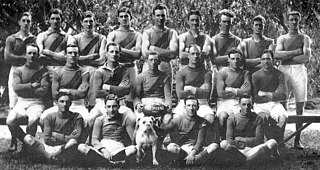
The Coburg Football Club, nicknamed the Lions, is an Australian rules football club based in the Melbourne suburb of Coburg. It has been based at Coburg City Oval since 1915.

The West Melbourne Football Club was an Australian rules football club which played in the Victorian Football Association (VFA). Its senior side competed in the VFA from 1878 through 1908, its peak as a club coming after it won the 1906 premiership. After disbanding at the end of the 1908 season, its identity was essentially overtaken by the North Melbourne Football Club, whose uniform briefly reflected the acquisition in the years following.

The 1888 Victorian Football Association season was the 12th season of the Australian rules football competition.

The 1897 Victorian Football Association season was the 21st season of the Australian rules football competition. The premiership was won by the Port Melbourne Football Club, the first premiership in its history.
The 1900 Victorian Football Association season was the 24th season of the Australian rules football competition. The premiership was won by the Footscray Football Club; it was the third premiership in the club's history, and the third in a sequence of three premierships won consecutively from 1898 to 1900.

The 1902 Victorian Football Association season was the 26th season of the Australian rules football competition. The premiership was won by the Richmond Football Club; it was the first premiership in the club's history.

The 1903 Victorian Football Association season was the 27th season of the Australian rules football competition. For the first time in its history, the VFA introduced an annual finals series to determine the premiership. The premiership was won by the North Melbourne Football Club, after defeating Richmond in the challenge final; it was the first premiership in the club's history, after having competed in the Association since its inaugural season in 1877.

The 1907 Victorian Football Association season was the 31st season of the Australian rules football competition. The premiership was won by the Williamstown Football Club, after it defeated West Melbourne in the final by eighteen points. It was the first premiership won by Williamstown, in its 24th season of senior competition.

The 1921 Victorian Football Association season was the 43rd season of the Australian rules football competition.
The 1924 match for Dame Nellie Melba's Appeal for Limbless Soldiers, informally known as the 1924 Championship of Victoria, was an Australian rules football exhibition match played on 4 October 1924 between the Essendon Football Club and the Footscray Football Club – who were that season's premiers of the Victorian Football League (VFL) and Victorian Football Association (VFA), respectively. Footscray recorded an upset victory against Essendon by 28 points, giving the VFA one of its most significant victories, on-field or off-field, against its stronger-rival competition. The match raised £2,800 for the fund.
The 1925 Victorian Football Association season was the 47th season of the Australian rules football competition. The premiership was won by the Brunswick Football Club, after it defeated Port Melbourne by 16 points in the final on 31 August. It was the club's second VFA premiership.
The 1928 Victorian Football Association season was the 50th season of the Australian rules football competition. The premiership was won by the Coburg Football Club, after it defeated Port Melbourne by seven points in the final on 8 September. It was the club's third VFA premiership, achieved in only its fourth season of senior competition, and was the third in a sequence of three premierships won consecutively from 1926 until 1928.
The 1931 Victorian Football Association season was the 53rd season of the Australian rules football competition. The premiership was won by the Oakleigh Football Club, after it defeated Northcote by three points in the Grand Final on 26 September. It was the club's second VFA premiership, achieved in only its third season of senior competition, and it was Oakleigh's second premiership in a row.

The 1939 Victorian Football Association season was the 61st season of the Australian rules football competition. The premiership was won by the Williamstown Football Club, which came from fourth on the ladder to defeat Prahran by nine points in the Grand Final on 7 October. It was the club's third VFA premiership, and it was a strong revival after having won the wooden spoon in 1938.
The 1942 Victorian Football Association season was not played owing to World War II, which was at its peak at the time.

The 1945 Victorian Football Association season was the 64th season of the Australian rules football competition, and it was the first season played since the Association went into recess during World War II. The premiership was won by the Williamstown Football Club, which defeated Port Melbourne by 37 points in the Grand Final on 6 October. It was the club's fourth VFA premiership.
The 1959 Victorian Football Association season was the 78th season of the Australian rules football competition. The premiership was won by the Williamstown Football Club after it defeated Coburg in the Grand Final on 10 October by 35 points. It was Williamstown's tenth premiership, taking it past Footscray to become the club with the most premierships won in VFA history, a title it held until it was passed by Port Melbourne in 1976; it was also the fifth of five premierships won in six seasons between 1954 and 1959, and the club's fourth consecutive minor premiership.
The 1990 Victorian Football Association season was the 109th season of the Australian rules football competition. The premiership was won by the Williamstown Football Club, after it defeated Springvale in the grand final on 30 September by two points; it was Williamstown's twelfth top-division premiership.
The Victorian Junior Football Association (VJFA), sometimes known simply as the Victorian Junior Association (VJA), was an open age Australian rules football competition and administrative body. It was the first successful junior football competition in Melbourne, and was in existence from 1883 until 1932.










